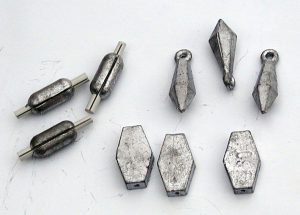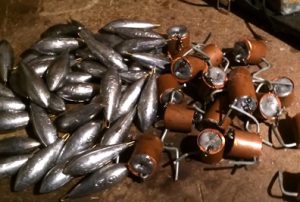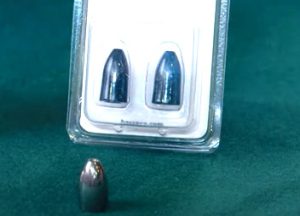Why Do Fishing Rods Have Lead? Which parts contain this composition? Are they all toxic? If you have any of the above questions, please read this helpful post immediately.
Contents
Introduction
Why do fishing rods have lead? Since ancient times, when people went fishing, they knew how to use rocks tied to fishing lines, supporting the bait to sink into the water.
But over time, modern life comes with the appearance of metal. Lead material is known to be a great step forward in making fishing trips much simpler.
Using fishing lead properly and effectively is to use as small a lead as possible. That is, the bait will be dominant, showing off the effect of attracting fish without fear of being seen by the fish, or the lead will be attached to the bottom so that the cowardly fish can eat the bait.

Why Is Lead Used For Fishing?
Born very early, fishing lead created by the Egyptians should have been applied to fishing about 5,000 to 7,000 years ago.
Fishing lead is understood as a weight in the fishing line, created to throw the bait at a distance, ensuring that the bait is always in the right position so that the fish can quickly find the bait.
No other material, lead, was chosen because the weight of this metal material is heavy, soft, and not easily oxidized, or chemical reactions occur when underwater. Lead also melts well at low temperatures and is easily molded into different shapes and sizes.
And most importantly, the fishing lead also attaches the eyelet without any obstacles and difficulties, and the price is very affordable. This can be considered a superior advantage over some other metals.

Do All Fishing Rods Have Lead?
Lead can be found in fishing rods, but not all fishing rods have lead. Also, the lead content in one fishing rod is typically minimal and isn’t considered a health hazard.
Lead is present in the coating or paint used on certain fishing rods. This is also occasionally used as one weight to help to balance the rod.
The lead content in one fishing rod is typically very small and poses no health risk. Nevertheless, when you are worried about the risk of lead exposure, users can select lead-free rods.
There are numerous excellent non-lead fishing rod choices available. As a result, if you’re searching for one new pole or want to ensure that the one users have is one lead-free tool, you can have many options.
Are All Fishing Weights Made Of Lead?
Only some types with fishing weights are made of lead. Lead was made long ago and is still used today; some other metal is replacing it.
Tungsten metal has become a popular replacement for fishing lead because it is heavier and has a higher structural density than lead. Anglers feel more sensitive when hitting the bottom of the water. The percentage of material is less and heavier than lead, so it has a smaller shape.
There is also 1 type of rubber lead. Elongated rubber lead shape, with an additional black rubber pad in the center of the grip slot. Sometimes this lead has a round shape, but the two rubber pieces always form two small ears at the ends.
Why Do Fishing Rods Have A Cancer Warning?
A colored paint that makes fishing poles shine is well-known to most anglers. Nevertheless, only some are aware that this coat contains lead. Lead is indeed a carcinogen, which means it causes cancer.
For this reason, some countries need safety warnings on products to inform users of the potential risks. The carcinogenic properties of lead paint on fishing rods are not an exception. As a result, anglers must be aware of the dangers of consecutively using the gear.
Lead paint can cause cancer and congenital disabilities in people who don’t use it. When fishers immerse the lead-covered fishing rods in the water, a heavy metal soaks into what can become drinking for humans.
Alternatively, the chemicals in the water would be absorbed by the fish. Humans will consume lead if they consume these fish.
Is Fishing Lead Toxic?
In fact, it is not toxic to users due to the small amount of lead in the weight of fishing rods, but it can affect the environment.
Because lead contains many toxins, countries such as the US, UK, and Canada have laws banning the use of lead in national parks or places where ecological conservation is required to be less harmful to the environment and organisms.
However, other manufacturing materials, such as tungsten, brass, copper, bismuth, and even hard plastics with heavy density or porcelain enamel, are too expensive (from 4 -8 times) compared to the price of lead, so the replacement of lead in fishing has changed very slowly.
After all, regular anglers are exposing themselves to long-term exposure, increasing their chances of getting cancer from their rod.

Is It Safe To Touch Lead Fishing Weights?
It is extremely safe to touch this item. Even anglers must know how to use different lead weights for the best fishing results.
After handling lead weights, wash your hands with water and soap. This can assist in the removal of any lead that might have contaminated the hands.
Also, whenever possible, utilize non-lead fishery weights. There still are numerous non-lead materials available. Therefore there is no reason to use lead ones if a safer option is available.
You’re fine because you’re not eating those lead weights; it will not be an issue if you’re melting or molding lead. Even so, tungsten is more environmentally friendly and will save you money if you get snagged.

Conclusion
Why do fishing rods have lead? Some may wonder why the part we temporarily gave its name is made of lead, not other heavy metals like iron or steel.
According to some knowledge of physics, lead is a natural substance with a very heavy specific gravity. The ability to sink underwater is also deeper, thanks to a piece of lead weighing a few grams.
Also, this material does not oxidize as quickly as other metals. Furthermore, the smelting of lead and casting into the distinctive shapes of fishing lead today. Also, applied at lower temperatures, easier to form in the fishing industry.


